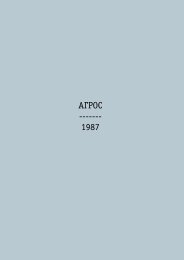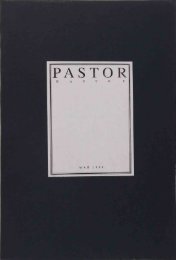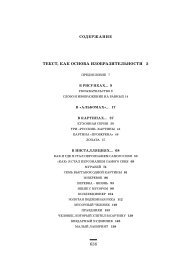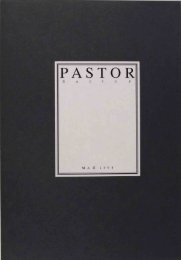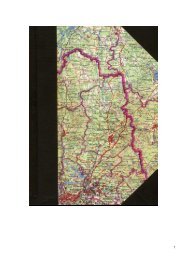Иллюстрацией упомянутой эволюции является работа НикитыАлексеева – изображенная на 36-метровом рулоне бумаги Краткаяистория современного искусства, или жизнь и смерть Черного квадрата.Это последняя работа Алексеева, сделанная в 1986 году, перед егоотъездом в Париж. В 70-е годы Алексеев входил в группу Коллективныедействия, а в начале 80-х открыл в своей квартире так называемуюГалерею АптАрт, которая стала важнейшей точкой актуальногоискусства в Москве; в 1983 году Захаров выставлялся там вместе сосвоим соавтором Виктором Скерсисом. Чтобы как-то финансовоподдержать свой отъезд, Алексеев, пригласив художников и коллекционеров,устроил в мастерской на Фурманном аукцион собственныхработ. На этом аукционе Захаров и купил за 50 рублей упомянутыйрулон. Жизнеописание в виде комиксов начинается с момента,когда Черный квадрат вылупляется из яйца, далее рассказывается оего заоблачных полётах – у квадрата появились крылышки – затемописываются различные эпизоды его дальнейших взлетов и падений- до самой смерти на висилице. Эта ироничная рефлексия наобразы собственных утопий и идеологий, обрекающая на холостойход любую возможную альтернативную утопию или идеологию,отличает русское современное искусство последнего десятилетия.В 1989 году Захаров, как и большинство его друзей-художников,выехал на Запад. Всемирно-исторический масштаб этого событияотразился не только в личной биографии, но и на всем творчестве,и на коллекции Захарова. Если поначалу творчество и коллекциябыли еще раздельными областями, то теперь, на Западе, они совершенноодна с другой сливаются. Основав Издание Пастора Зонда,Вадим Захаров сумел увязать свое желание сохранять и потребностьскрываться; фактически издание стало не просто сборником, нозаказчиком и инициатором многочисленных проектов и произведениймосковских концептуалистов.Издание Пастора Зонда – необычное, домашнее издательство – располагаетсяна Глеуелер штрассе 22, там же, где с 1990 года Захаровживет и работает. Важнейший его орган – периодический журналПастор, изготовляемый вручную, маленьким тиражом, до сего днявыпущено восемь номеров, к сожалению, только на русском языке.Пастор является тематическим журналом, в котором обсуждаютсяlopment. It is the last work Alexeev did before he went toParis in 1986. A trained illustrator, Alexeev belonged to theCollective Actions group in the 1970s and maintained in hisflat as the so-called Apt-Art Gallery in the early 1980s, whichwas an important venue for contemporary art in Moscow,where Zakharov and Viktor Skersis exhibited together in1983. In order to finance his departure, Alexeev held an auctionof his works in his studio in Furmanny Street, to whichhe invited artists and collectors. At this auction Zakharovbought the scroll for 50 roubles. It narrates its story in thestyle of a comic strip, begins with the birth of the blacksquare from an egg, tells of its flights of fancy – the squareacquires little wings – and leads, via various revivals, to itsultimate death on the gallows. This ironical reflection on theimages of one’s own utopias and ideologies, which deny allpossibility of an alternative utopia or ideology coming to anything,is typical of the Russian art of the past two decades.Like most of his artist friends, Zakharov departed for theWest in 1989. The world-historical dimension of this caesurais reflected not only in his personal curriculum vitae, but alsoin his work and the Zakharov collection. Whereas work andcollection were originally separate areas, they began tomerge with each other completely after his departure. Theneed for a link between the Desire-to-Preserve and theInevitabili-ty-of-Disappearance was Vadim Zakharov’s justificationfor his Pastor Zond Editions, which have not onlybecome a receptacle, but also an inspiration and initiator fornumerous projects and works of the Moscow Conceptualists.Pastor Zond Editions is no ordinary publishing house, buta family publishing house located at Gleulerstrasse 22 inCologne, where Zakharov has lived and worked since 1990.Its most important organ is the periodical Pastor, eight issuesof which have appeared to date in a small, hand-crafted edition,mostly, alas, in Russian. Each issue of Pastor is devotedto the discussion of a topical issue concerning contemporaryart, art history, literature or philosophy. Text and illustrationsare by Russian artists and poets of the Moscow ConceptualSchool. The authors are mainly contemporary Russianartists: Yuri Albert, Erik Bulatov, Andrei Monastyrski, IlyaKabakov, Komar & Melamid, Yuri Leiderman, Oleg Vasiliev,Victor Pivovarov, Andrei Filippov or the Medical Hermeneuticsgroup, a few western artists, like Terry Atkinson or RainerGanahl, poets like Dmitri Prigov, Lev Rubinshtein or Mikhail
актуальные проблемы современного искусства, искусствоведения,литературы и философии. Тексты и иллюстрации для публикацийприсылают русские художники и поэты, принадлежащие к московскойконцептуальной школе. Среди авторов журнала прежде всегосовременные русские художники: Юрий Альберт, Эрик Булатов,Андрей Монастырский, Илья Кабаков, Комар и Меламид, ЮрийЛейдерман, Олег Васильев, Виктор Пивоваров, Андрей Филиппов,группа “Медгерменевтика”, некоторые западные художники – ТерриАткинсон, Райнер Ганал, а также поэты – Дмитрий Пригов, ЛевРубинштейн, Михаил Сухотин и философы - Борис Гройс, МихаилРыклин, Виктор Тупицын. Основанное в 1992 году, непосредственнопосле падения железного занавеса, Издание Пастора Зондасовершает и тематизирует идеологический переход – фонетическиПастор – от Востока к Западу. При этом создатель Издания Захароввидит себя пастором, то есть пастухом, который заботливо отыскиваетразбежавшихся овец (Зонд от зондировать) и собирает их встадо. Таким образом журнал Пастор становится форумом для дискуссийи своего рода пристанищем для рассеявшихся по всему мирусо времен Перестройки художникам. Весь облик журнала Пасторблизок русской традиции Самиздата, сродни изготовленной вручнуюпечатной продукции неофициальной русской культурной сцены.Если в свое время тоталитарная система и цензура были фономмашинописных публикаций Самиздата, то Захаров культивируетподобный образ производства, мотивируя это теперь уже не содержаниемжурнала, а экономическими причинами. При этом ставитсявопрос – не без ноток нос-тальгии и достаточно иронично: а чем,собственно, отличаются производтсвенные условия тоталитарнойотчизны от условий в свободном государстве, предоставившемхудожнику убежище?В границах Издания Пастора Зонда Захаров развивает невероятносложную и дотошно разработанную сеть между московскими концептуальнымихудожниками, где собственная мифология и историяэтого круга воплощается в произведение искусства. Так в 1994 годуЗахаров попросил двадцать художников сделать макеты обложекдля своего журнала. Каждый из макетов был распечатан на двадцатикрасных листах бумаги, собранных в изготовленную вручную папку;Sukhotin, and philosophers like Boris Groys, Mikhail Ryklin,Victor Tupitsyn and others. Founded in 1992, im-mediatelyafter the fall of the Iron Curtain, Pastor Zond Editions thuscompletes and addresses the ideological transition fromEast to West – when said aloud, “Pas-Tor” sounds like theGerman for “passing the gate”. Founder Zakharov considershimself a pas-tor in the sense of a shepherd who patientlyseeks out (Russian: zond = to probe) his artist friends, disbandedlike sheep, and corrals them together. Thus the periodicalPastor offers a discussion forum and a kind of substitutehome for the artists scattered over all four corners of theworld since perestroika, especially as Pastor’s image is in thefamiliar Russian tradition of “samizdat”, the manually duplicatedpublications of the unofficial Russian cultural scene.While the censorship of the totalitarian system was the originalreason for the manual duplication of samizdat publications,Zakharov now cultivates this mode of production, whosedilemma lies no longer in political but in economic factors.This raises the question – which is not without an undertoneof nostalgic irony – as to what distinguishes the relations ofproduction in his former totalitarian homeland from those in afreedom-loving democracy? And what, in the computer age,distinguishes manual from machine production?At Pastor Zond Editions Zakharov is developing an unusuallycomplicated and elaborate network of MoscowConceptualist artists, in which the group’s own mythologyand history are themselves made the subject of art. In1994, for example, Zakharov requested twenty artists to submitcover designs for his periodical, which he then publishedunder the title of Pastors Umschlag (Pastor’s Cover). Each ofthese designs was printed on twenty red sheets of paperinserted in a hand-made folder, while the originals remainedin the collection of the artist. The publication Aus der Vita desdurchnäßten Starez (From the Life of a Drenched Old Man),1993-94 is also constructed on a similar principle. It consistsof two leporellos or zigzag folders, one black and one white.The black leporello contains 19 initials of Moscow artists,each framed by a computer file window. The white leporellocontains 19 black-and-white photos of the same artists whenthey were children. The ironic cultivation of their own mythsand groups shows a special esteem for the innocent creativityof childhood. Zakharov has been working since 1994 on acollection entitled Pastor Zond Children’s Library, for which
- Page 2 and 3:
ЕЖЕГОДНЫЙ МЕЖДУНАР
- Page 5:
Объекты радикально
- Page 9 and 10:
Большого театра. Ка
- Page 11 and 12:
мы, её динамики, её
- Page 13 and 14:
является архивом, а
- Page 15 and 16:
Автопортрет с завя
- Page 17 and 18:
Кабачок/ Kabachok (Marrow Sq
- Page 19 and 20:
Портрет В. Захарова
- Page 21 and 22:
Потерянный день/ Lost
- Page 23 and 24:
Краткая история со
- Page 25 and 26:
Краткая история со
- Page 27 and 28:
1. Трещины на стене.2
- Page 29 and 30:
1. Магнитофон «Grundig»
- Page 31 and 32:
1. Саксофон, выданны
- Page 33 and 34:
1. Сломанный электр
- Page 35 and 36:
1. Бонги, принесенны
- Page 37 and 38:
1. «Наш флаг», изгот
- Page 39 and 40:
Портрет Монастырск
- Page 41 and 42:
В 1986 г. Герман Виног
- Page 43 and 44:
Художники! Прошу не
- Page 45 and 46:
Рисунок к изданию П
- Page 47 and 48:
Сирень/ Lilac, 1987СЕРГЕ
- Page 49 and 50:
Без названия/ Untitled,
- Page 51 and 52:
Шпиц/ Spitz, 1988
- Page 53 and 54:
АНАТОЛИЙ ЖУРАВЛЕВAN
- Page 55 and 56:
Я никогда ничего не
- Page 57 and 58:
Пролетарии, на пара
- Page 59 and 60:
Рисунок к изданию П
- Page 61 and 62:
Филенидка/ Filenidka, 1985
- Page 63 and 64:
Лукъянчик/ Lukjanchik, 198
- Page 65 and 66:
Труп отца!/ Father's Corpse
- Page 67 and 68:
Мне с нею познакоми
- Page 69 and 70:
Моя бабушка .../My Grandm
- Page 71 and 72:
ЕЛЕНА ЕЛАГИНАELENA ELAG
- Page 73 and 74:
Вредители/ Pests, 1999
- Page 75 and 76:
Спальный мешок из с
- Page 77 and 78:
Кережка и волокуша
- Page 79 and 80:
Исход/ Exodus, 1976, 1983ИГ
- Page 86 and 87:
Серию Выбор цели я
- Page 89 and 90:
Лозунг КД (Коллекти
- Page 91 and 92:
Made in Slum/ Made in Slum, 2007
- Page 93 and 94:
АНДРЕЙ МОНАСТЫРСКИ
- Page 95 and 96:
Посвящение Вадиму
- Page 97 and 98:
Смерть мухам / Death to
- Page 99 and 100:
Глубокая задумчиво
- Page 101 and 102: ВЛАДИМИР НЕМУХИНVLAD
- Page 103 and 104: Валет. Из серии рис
- Page 105 and 106: ПАВЕЛ ПЕППЕРШТЕЙНPA
- Page 107 and 108: Динарий Кесаря/ Cesar
- Page 109 and 110: Поединок Номы и Сов
- Page 111 and 112: ВИКТОР ПИВОВАРОВVIKT
- Page 113 and 114: Донесение о состоя
- Page 115 and 116: ДМИТРИЙ ПРИГОВDMITRI P
- Page 117 and 118: Рисунок к изданию П
- Page 119 and 120: Без названия/ Untitled,
- Page 121 and 122: Артек/ Artek, 1989
- Page 123 and 124: АНДРЕЙ РОЙТЕРANDREI ROI
- Page 125 and 126: ВИКТОР СКЕРСИСVIKTOR S
- Page 127 and 128: Модель искусства /Th
- Page 129 and 130: Музыкальные инстру
- Page 131 and 132: Машина Юстиции / Machi
- Page 133 and 134: Лес / The Forest, 1985
- Page 135 and 136: АНДРЕЙ ФИЛИППОВANDREI
- Page 137 and 138: Приглашение на ужи
- Page 139 and 140: ЧЕМПИОНЫ МИРАГиа А
- Page 141 and 142: Таймс / The Times, 1986
- Page 143 and 144: Эта работа первона
- Page 145 and 146: Рисунок к изданию П
- Page 147 and 148: Без названия (Лодки
- Page 149 and 150: Серия рисунков, соб
- Page 151: До р о т е я Цв и р н
- Page 155 and 156: время важных мероп
- Page 157 and 158: Пастор Nr.1 - Имена / Pa
- Page 159 and 160: Никита Алексеев, Юр
- Page 161 and 162: Иллюстрации к Детс
- Page 163 and 164: В ос но ву из да ния
- Page 165 and 166: Достаточно легкого
- Page 167 and 168: Вла д и м и р На у м е
- Page 169 and 170: For the sake of simplicity a diagra




